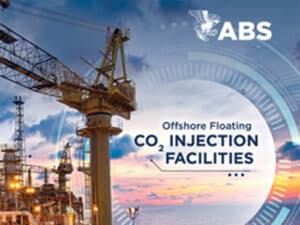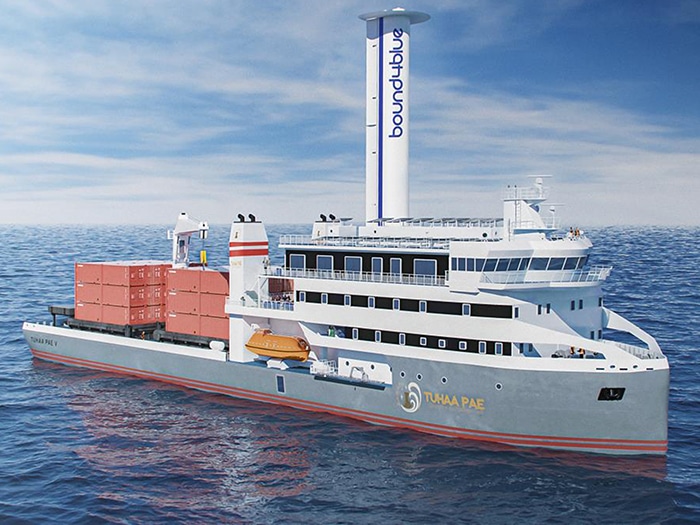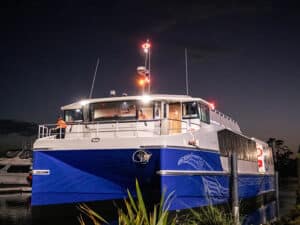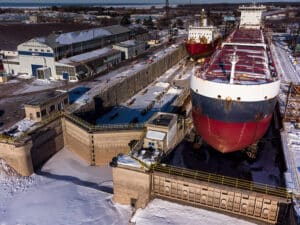
Na Hiro E Pae will sail the South Pacific with an eSAIL
Written by Nick Blenkey
Image: Cotenaval
An 89-meter long mixed cargo/passenger vessel to be built at the Armon Shipyard in Spain for Papeete, French Polynesia, based SNA Tuhaa Pae is to be fitted with a 22 meter high bound4blue eSAIL. The vessel, the Na Hiro E Pae, will operate between Tahiti and the Austral Islands, 400 miles to the southwest of Tahiti, carrying bothsupplies and up to 200 tourists.
SAILING WITH SUCTION
The eSAIL, designed for both retrofits and newbuilds, is a “suction sail.” It works by harnessing wind power to propel vessels, employing an autonomous vertical sail with suction technology, dragging air over a think aerodynamic profile. According to bound4blue, the process generates seven times more lift than a conventional airplane wing, resulting in exceptional propulsive efficiency, greatly reducing the load on main engines – saving fuel and cutting emissions.
David Ferrer, co-founder and CTO of bound4blue, comments: “This is stand-out contract for bound4blue, marking the first time our technology has been chosen for a newbuild, after a very competitive international tender process. We believe this demonstrates the growing appreciation of our unique offer, and expertise, within the global marketplace. The eSAIL,effectively provides a modern twist to the ancient tradition of harnessing the trade winds of the Southern Pacific. It allows this forward-thinking owner to achieve strong environmental and commercial benefits, taking advantage of an abundant renewable energy source to support a move away from fossil fuels.”
While this is bound4blue’s first newbuild contract, its previous retrofit contracts include commercial agreements with LDC for the installation of four 26 meter high eSAILs on the Louis Dreyfus Company chartered vessel M/V Atlantic Orchard and three 22 meter high units on the Ville de Bordeaux, used by Airbus to transport aircraft subassemblies.
ENVIRONMENTAL GOALS
Promising to reduce energy consumption by more than 10%, the single eSAIL will allow the French Government funded project to meet ambitious environmental objectives.
The Na Hiro E Pae has been designed by Spanish naval architecture firm Cotenaval with Marseille-based ECO, an approved verifier for the Green Marine Europe label, providing consultancy. Financial support has been awarded through the French Government’s Appel à Manifestation d’Intérêt initiative, with the project meeting criteria for local fleet renewal, opening up the Austral Islands, delivering cruise business, supporting local employment, and sustainability goals.
Cotenaval’s design process for the ship has been centered around providing it with state-of-the-art systems and an optimized design aimed at reducing overall energy consumption, emissions, and maintenance costs. Additionally, flexibility and quick loading/unloading operations have been key design focal points, with the comfort and appearance of the accommodation areas, providing ample space for leisure, and maintaining natural light, have also been crucial aspects of this design.
In addition to the eSAIL, Na Hiro E Pae will be fitted with engines capable of running on biofuel or e-fuel, as soon as it becomes commercially available in the region. It also offers efficiency in terms of waste treatment, electric podded propulsion and autonomy in fresh water supply. Cargo capacity is 1,500 tonnes, almost four times more than its predecessor, the Tuhaa Pae IV, translating to much reduced energy consumption and emissions per cargo tonne.
“The development of these beautiful islands, the sustainability of local economic activity, and the overall welfare of the population depends upon a strong maritime transport link,” said Boris Piel, technical director, SNA. “A new generation of vessel unlocks new possibilities for the communities here, and the Na Hiro E Pae has been designed to maximise that potential.”
“Sustainability and environmental stewardship were at the top of our agenda. bound4blue’s unique eSAILwas a market proven, mechanically robust choice,“ he added. “It is simple, stable, low maintenance and provides clear environmental benefits, working in tandem with the other propulsion systems to optimize power. The fact that it helps drive down OPEX provides a strong commercial argument. We can’t wait to sail in 2026.”




